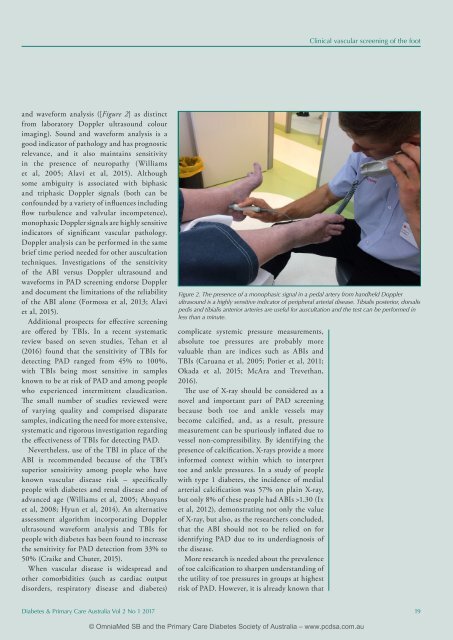DPCA2-1_16–24_wm
You also want an ePaper? Increase the reach of your titles
YUMPU automatically turns print PDFs into web optimized ePapers that Google loves.
Clinical vascular screening of the foot<br />
and waveform analysis ([Figure 2] as distinct<br />
from laboratory Doppler ultrasound colour<br />
imaging). Sound and waveform analysis is a<br />
good indicator of pathology and has prognostic<br />
relevance, and it also maintains sensitivity<br />
in the presence of neuropathy (Williams<br />
et al, 2005; Alavi et al, 2015). Although<br />
some ambiguity is associated with biphasic<br />
and triphasic Doppler signals (both can be<br />
confounded by a variety of influences including<br />
flow turbulence and valvular incompetence),<br />
monophasic Doppler signals are highly sensitive<br />
indicators of significant vascular pathology.<br />
Doppler analysis can be performed in the same<br />
brief time period needed for other auscultation<br />
techniques. Investigations of the sensitivity<br />
of the ABI versus Doppler ultrasound and<br />
waveforms in PAD screening endorse Doppler<br />
and document the limitations of the reliability<br />
of the ABI alone (Formosa et al, 2013; Alavi<br />
et al, 2015).<br />
Additional prospects for effective screening<br />
are offered by TBIs. In a recent systematic<br />
review based on seven studies, Tehan et al<br />
(2016) found that the sensitivity of TBIs for<br />
detecting PAD ranged from 45% to 100%,<br />
with TBIs being most sensitive in samples<br />
known to be at risk of PAD and among people<br />
who experienced intermittent claudication.<br />
The small number of studies reviewed were<br />
of varying quality and comprised disparate<br />
samples, indicating the need for more extensive,<br />
systematic and rigorous investigation regarding<br />
the effectiveness of TBIs for detecting PAD.<br />
Nevertheless, use of the TBI in place of the<br />
ABI is recommended because of the TBI’s<br />
superior sensitivity among people who have<br />
known vascular disease risk – specifically<br />
people with diabetes and renal disease and of<br />
advanced age (Williams et al, 2005; Aboyans<br />
et al, 2008; Hyun et al, 2014). An alternative<br />
assessment algorithm incorporating Doppler<br />
ultrasound waveform analysis and TBIs for<br />
people with diabetes has been found to increase<br />
the sensitivity for PAD detection from 33% to<br />
50% (Craike and Chuter, 2015).<br />
When vascular disease is widespread and<br />
other comorbidities (such as cardiac output<br />
disorders, respiratory disease and diabetes)<br />
Figure 2. The presence of a monophasic signal in a pedal artery from handheld Doppler<br />
ultrasound is a highly sensitive indicator of peripheral arterial disease. Tibialis posterior, dorsalis<br />
pedis and tibialis anterior arteries are useful for auscultation and the test can be performed in<br />
less than a minute.<br />
complicate systemic pressure measurements,<br />
absolute toe pressures are probably more<br />
valuable than are indices such as ABIs and<br />
TBIs (Caruana et al, 2005; Potier et al, 2011;<br />
Okada et al, 2015; McAra and Trevethan,<br />
2016).<br />
The use of X-ray should be considered as a<br />
novel and important part of PAD screening<br />
because both toe and ankle vessels may<br />
become calcified, and, as a result, pressure<br />
measurement can be spuriously inflated due to<br />
vessel non-compressibility. By identifying the<br />
presence of calcification, X-rays provide a more<br />
informed context within which to interpret<br />
toe and ankle pressures. In a study of people<br />
with type 1 diabetes, the incidence of medial<br />
arterial calcification was 57% on plain X-ray,<br />
but only 8% of these people had ABIs >1.30 (Ix<br />
et al, 2012), demonstrating not only the value<br />
of X-ray, but also, as the researchers concluded,<br />
that the ABI should not to be relied on for<br />
identifying PAD due to its underdiagnosis of<br />
the disease.<br />
More research is needed about the prevalence<br />
of toe calcification to sharpen understanding of<br />
the utility of toe pressures in groups at highest<br />
risk of PAD. However, it is already known that<br />
Diabetes & Primary Care Australia Vol 2 No 1 2017 19<br />
© OmniaMed SB and the Primary Care Diabetes Society of Australia – www.pcdsa.com.au
















